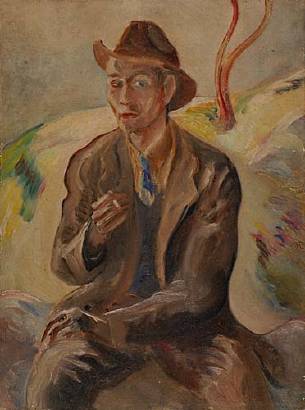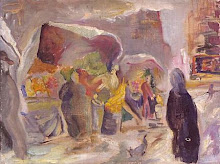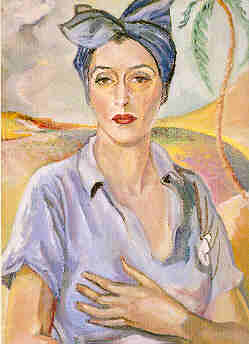Edward Estlin Cummings dreamed of becoming a poet from a very early age (personal.carthage.edu). Estlin’s mother, Rebecca Cummings, introduced him to literature and writing, and his father, Edward Cummings, nourished Estlin’s writing skills. Rebecca Cummings enjoyed playing with her children, and was called a loving mother by her daughter, Elizabeth Cummings, seven years Cummings’ younger. Rebecca Cummings was a self-educated woman, like her husband, and was knowledgeable about varies languages and literature. The Cummings family was a well-known, well-educated family in Cambridge, Massachusetts, where Estlin was born on October 14, 1894. His father was a Harvard professor in Sociology and Political Science (Eich). Cummings father was deeply interested in the social issues, and later became a Unitarian minister to fully complete his life’s ambition (Sawyer-Lauçanno). In Cummings’ eyes, his father was a renaissance man,, skilled in almost everything he attempted. From a very young age the Cummings parents made it clear they expected marvelous things from their son; his mother made him a sweater with an “H” for Harvard, and his father took him on walks through the school’s campus (Sawyer-Lauçanno). Cummings lived up to such expectations beautifully; he drew accurate renderings of animals at three or four, as well as writing fragmented poetry and diary entries.
When Estlin entered Harvard as a freshman, he took a few language classes, Philosophy and Physiology I. To his father’s disappointment, he struggled in philosophy; Cummings could not put his mind into such a traditional thought patterns(Sawyer-Lauçanno). During his first year he was notably separate from his fellow classmates, and spent considerable time in the library, becoming enchanted with Marlowe and Ovid. Cummings Greek teacher, Theodore Miller, encouraged him to translate Medea, and it became apparent that Cummings was not only interested in the translation but, “in making the poetry of Euripides come alive” (Sawyer-Lauçanno). Miller and Cummings came to be close friends, and would exchange books lovingly. Throughout these first years at Harvard Cummings discovered poets and writers infinitely, and came to be a very well read youth. Cummings came to so enjoy himself at Harvard that he stayed on an extra year to earn his masters in English Literature, an easy course with liberal class choices.
In January 1917, Cummings joined the Ambulance Corps, attached to the French Army, for a six-month tour, where he met William Slater Brown, who would become his life-long friend. Cummings and Brown were suspected of being critical of the French war effort after five months, and thus shipped to the detention barracks. They were later tried and released, and this experience provided the basis for his book The Enormous Room (Poets.org). Cummings returned to live in the US, but made frequent visits to Europe, where he met artists (like Pablo Picasso, whom he admired greatly) and poets (Poets.org). Cummings at first returned to his parents’ home for recuperation after the detention barracks and malnutrition (Sawyer-Lauçanno). After he recovered he was drafted into the army, and served in the 73rd Infantry Division, and was stationed at Camp Devens in Massachusetts (Blei). When he returned from serving, Cummings took the first opportunity he could to escape the “nest” and moved to New York (Yardley, 2004).
In New York, Cummings focused on his art and poetry, delving into his styles deeper than before (Yardley, 2004). He continually travelled outside of the US, regularly to Paris, but also to the Soviet Union, and even Northern Africa (Blei). Cummings had varies writing jobs, but nothing ever captured his interest so much as being a solo artist. Cummings father, Edward Cummings, died in a car crash, and Estlin was utterly devastated. He completely altered himself, and became a devout Unitarian, his poems became much more religious (Sawyer-Lauçanno). Throughout the rest of Cummings life, he gave “non-lectures” at colleges, and toured the country (Sawyer-Lauçanno). His health began to decline, and he was unable to travel very much around 1960, his poems also became graver (Sawyer-Lauçanno). Cummings died on September 3 in 1962 in North Conway, New Hampshire (notablebiographies.com).
Throughout E. E. Cummings’ life he was married three times, and with his first wife, he had his only child, Nancy Cummings (Blei). One of Cummings’ friends from Harvard, Scotfield Thayer, was married to Elaine Orr. Orr and Cummings began a love affair in 1919, after he returned from Camp Devens. Nancy was born on December 20 in 1919. Orr was able to divorce Thayer, and married Cummings in March 1924. They divorced only nine months later when Orr left Cummings for a rich Irish banker. Under the divorce terms, Cummings was supposed to see Nancy for three months of every year, but Orr refused to follow the terms (Blei). 1946 was the next time that Cummings was able to see his daughter. Cummings second wife was Anne Minnerly Barton; they were married for three years, 1929-1932. They separated, and Barton got a Mexican divorce that was not acknowledged in the US until 1934. The same year that Cummings and Barton separated, Cummings met a fashion model and photographer, Marion Morehouse (Blei). Morehouse lived with Cummings until his death, but it is unknown whether they ever legally got married. Morehouse died seven years after Cummings in their house.
Cummings uses his poetry to express the essence of things (Webster, 2000). This is most evident in his nature and animal poems. In his poem about a grasshopper, he uses “seemingly arbitrary…spacing, capitalization, and punctuation,” to better “re-enact the seemingly arbitrary leap(s) of grasshopper” (Webster, 2000). Webster also states that he could not only be trying to capture the essence of the grasshopper, but be presenting “the otherness of the insect by deforming that most distinctive human invention, language.” Cummings was dearly intent on creating poetry that was visual and orally effective; the reader would only feel the true impact if they saw the poem’s shape, and/or read it aloud. Cummings makes many references to voice, sound and silence, as shown in this poem:
some ask praise of their fellows
but i being otherwise
made compose curves
and yellows,angles or silences
to a less erring end)
myself is sculptor of
your body’s idiom:
the musician of your wrists;
the poet who is afraid
only to mistranslate
a rhythm in your hair,
(your fingertips
the way you move)
the
painter of your voice
beyond these elements
remarkably nothing is.
Isabelle Alfandry (2000) commented on this poem:
“The reference to silence hardly ever comes without that of voice because silence implies voice just as voice does silence. Yet silence does not logically contradict voice in Cummings mind…Silence is a prerequisite for the voice, a space for it to invest…In silence resounds voice, in voice silence is present. Poetry in turning the invisible silence or a voice into perception and presence.”
Cummings love of nature and its cycles is present throughout his poetry. He also painted many landscape pictures, and still life. His Unitarian faith imposed into his poetry by creating in him a love of the simple and whole. In his readings by Marlowe, when he was at Harvard, he remarked that he enjoyed the erotic aspects (Sawyer-Lauçanno), later he also had a slight obsession with prostitutes (shown in his multitude of portraits of varies naked women); Cummings wrote some 271 nearly pornographic poems (Landles, 2004).
Cummings most likely would have agreed with George Santayana’s statement about the Harvard students, in their time: “intelligent, ambitious, remarkably able ‘to do things’; they were keen about the matter that had already entered into their lives, and invincibly happy in their ignorance of everything else” (Sawyer-Lauçanno). Cummings used his poetry to make his reader think, he did not want a passive reader, but somebody thinking and seeing and engaging with the poems. He used shapes, unusual spaces, odd punctuation and blending of different kinds of poetry to catch the reader’s attention, and keep them captivated.
Cummings used syncretism to the utmost; in his poem “next to of course god america i” he combined both the Italian and English sonnet. The syntax in this poem is inverted in many places, and Davis commented:
“[A] poem which expresses a theme on ‘inverted’ or confused philosophy, cummings, as a persona, inverts his apparently objective commentary on the situation and the words in which he reports his commentary…this syntactical inversion here at the end of the poem serves to indicate the similar transformation///of the sonnet form which cummings has effected in terms of form and further serves to point to the ‘inverted’ philosophy of the speaker of lines one through thirteen.”
In this poem, Cummings wrote many patriotic phrases, but it is obviously satirical, like much of his poetry, and provides a beautiful example of his anti-war/pacifist views. He openly critiques the government; he believed that one should be able to do and think as one wanted (individualism) and was most likely a true believer in Freedom of Speech. Cummings critiques the politicians’ role in oppressing liberty for nationalism (Brian).
Cummings wrote countless poems, plays and books; he painted numerous landscapes, still arts, prostitutes, and a number of pictures of his third wife, Marion Morehouse. He won an incredible amount of awards, and did his best to make people think and to fulfill his art infested desires.
Works Cited
Alfandary, Isabelle. "Voice and Silence in E.E.Cummings’ Poetry." Grand Valley State University. 2000. Web. 09 Mar. 2010.
Blei, Norbert. "E.e. Cummings | 14." Poetry Dispatch & Other Notes from the Underground. Web. 08 Mar. 2010.
Davis, William V. "E.E.Cummings." Welcome to English. Web. 09 Mar. 2010.
Docherty, Brian. "E.E.Cummings." Welcome to English. Web. 09 Mar. 2010.
"E. E. Cummings Biography - Life, Family, Children, Story, Death, Wife, Mother, Book, Old, Information, Born, Time, Achievements, Sister." Encyclopedia of World Biography. Web. 08 Mar. 2010.
"E. E. Cummings Biography." Carthage College - Into a Larger World. Web. 08 Mar. 2010.
"E.E. CUMMINGS: POET AND PAINTER." Harvard Square Library | Unitarian Biographies | Cambridge | History | Philosophy. Web. 07 Mar. 2010.
"E.E. Cummings." Www.kirjasto.sci.fi. Web. 08 Mar. 2010.
Eich, Marty. "E. E. Cummings Biography." Famous Poets and Poems - Read and Enjoy Poetry. Web. 08 Mar. 2010.
Friedman, Norman. "E. E. Cummings: The Growth of a Writer." Southern Illinois University Press [Carbondale] 1964. Print.
Kennedy, Richard S. Dreams in The Mirror: A Biography of E. E. Cummings. New York: Liveright, 1980. Print.
Landles, Iain. "An Analysis of Two Poems by E.E.Cummings." Green Valley State University, 2001. Web. 8 Mar. 2010.
Landles, Iain. "Review of Christopher Sawyer-Lauçanno,E. E. Cummings: A Biography." Rev. of E. E. Cummings: A Biography. 1-608. Grand Valley State University. Sourcebooks, 2004. Web. 8 Mar. 2010.
Marks, Barry A. E. E. Cummings. New York: Twayne, 1964. Print.
Norman, Charles. E. E. Cummings: The Magic-Makes. New York: Duall, Sloan and Pearce, 1958. Print.
"The Paintings of E.E. Cummings: Drawings." Ken Lopez - Bookseller: The Paintings of E. E. Cummings. Web. 07 Mar. 2010.
"E. E. Cummings -." Poets.org - Poetry, Poems, Bios & More. Web. 08 Mar. 2010.
Sawyer-Lauçanno, Christopher. E.E. Cummings: a Biography. Naperville, IL: Source Inc, 2004. Print.
Webster, Michael. "EEC: The Old Nature Poetry and the New." Grand Valley State University. 2000. Web. 09 Mar. 2010.
Yardley, Jonathan. "'E.E. Cummings: A Biography' (washingtonpost.com)." Washingtonpost.com - Nation, World, Technology and Washington Area News and Headlines. The Washington Post, 17 Oct. 2004. Web. 08 Mar. 2010.












No comments:
Post a Comment